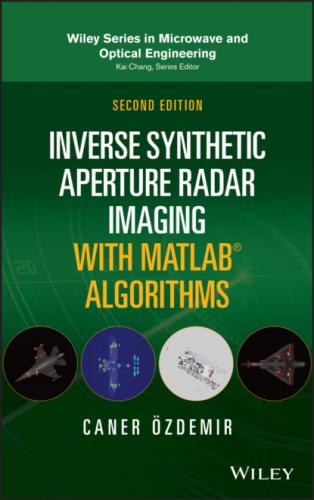For the frequency‐domain signal in Figure 1.11b or c, the frequency bandwidth is 1000 Hz with N = 10 samples. Therefore, the sampling interval in frequency is 100 Hz. After applying IDFT to get the time‐domain signal as in Figure 1.11a, the formulas in Eqs. 1.27 and 1.28 calculate the resolution in time as 0.1 ms and the duration of the signal as 1 ms.
1.8 Aliasing
Aliasing is a type of signal distortion due to undersampling the signal of interest. According to Nyquist–Shannon sampling theorem (Shannon 1949), the sampling frequency fs should be equal to or larger than twice the maximum frequency content; fmax of the signal to be able to perfectly reconstruct the original signal:
(1.29)
Since processing the analog radar signal requires sampling of the received data, the concept of aliasing should be taken into account when dealing with radar signals.
1.9 Importance of FT in Radar Imaging
The imaging of a target using electromagnetic waves emitted from radars is mainly based on the phase information of the scattered waves from the target. This is because of the fact that the phase information is directly related to the range distance of the target. In the case of monostatic radar configuration as shown in Figure 1.12a, let the scattering center on the target be at R distance away from the radar. Then, the scattered field Es from this scattering center on the target has a complex scattering amplitude, A and a phase factor that contains the distance information of the target as follows:
As is obvious from Eq. 1.30, there exists a Fourier relationship between the wave number, k, and the distance, R. Provided that the scattered field is collected over a bandwidth of frequencies (Figure 1.12b), it is possible to pinpoint the distance R by Fourier transforming the scattered field data as depicted in Figure 1.12c. The plot of scattered field versus range is called the range profile, which is an important phenomenon in radar imaging. Range profile is, in fact, nothing but the one‐dimensional range image of the target. An example is illustrated in Figure 1.13 where the range profile of an airplane is shown. The concept of range profiling will be thoroughly investigated in Chapter 4, Section 4.3.
Figure 1.12 (a) Monostatic radar configuration, (b) scattered field versus frequency, (c) range profile of the target.
Figure 1.13 Simulated range profile of an airplane.
Another main usage of FT in radar imaging is the ISAR imaging. In fact, ISAR can be regarded as the 2D range and cross‐range profile image of a target. While the range resolution is achieved by utilizing the frequency diversity of the backscattered signal, the cross‐range resolution is gathered by collecting the backscattered signal over different look angles of the target. An example of ISAR imaging for the same airplane is demonstrated in Figure 1.14 where both the CAD view and the constructed ISAR image for the airplane are shown. The concept of ISAR imaging will be examined in great detail in Chapter 4.
The FT operations are also extensively used in synthetic aperture radar (SAR) imaging as well. Since the SAR data are usually huge and processing this amount of data is an extensive and time‐consuming task, the FTs are usually utilized to speed up signal processing procedures such as range and azimuth compression.
An example of SAR imagery is given in Figure 1.15 where the image was acquired by spaceborne imaging radar‐C/X‐band synthetic aperture radar (SIR‐C/X‐SAR 1997) onboard the space shuttle Endeavour in 1994 (www.jpl.nasa.gov/radar/sircxsar/capecod2.html). This SAR image covers an area of Cape Cod, Massachusetts. The details of SAR imagery will be explored in Chapter 3.
Figure 1.14 Simulated 2D ISAR image of an airplane.
Source: Caner Ozdemir.
Figure 1.15 SAR image of the famous “hook” of Cape Cod, Massachusetts, USA.
Source:www.jpl.nasa.gov/radar/sircxsar/capecod2.html.
1.10 Effect of Aliasing in Radar Imaging
In radar applications, the data are collected within a finite bandwidth of frequencies. According to the sampling theory, if the radar signal is g(t) and its spectrum is G(f), the frequency components beyond a specific frequency B is zero, that is
(1.31)
then the time‐domain signal g(t) should be sampled at least twice the bandwidth in frequency as
(1.32)
where fs stands for the sampling frequency.
When the radar imaging is concerned, the scattered electric field has the form as given in Eq. 1.30. The sampling theorem can be applied in the following manner:
Suppose that target to be imaged lies in the range direction within the range width or range extend of Rmax
